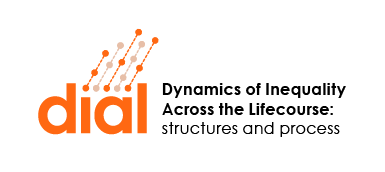23 June 2020
DIAL organized its second virtual EU Stakeholder meeting with the topic of overcoming childhood disadvantages on June 23, 2020. Researchers from four DIAL projects (IMCHILD, GUODLCCI, PremLife and SEED) presented their research on the causes and consequences of childhood disadvantages and how these can be addressed in Europe. Representatives from the European Commission’s Social affairs unit (DG Employment, Social Affairs and Inclusion) and Evidence-based policy and evaluation unit (DG Education, Youth, Sport and Culture) took part in the discussion.
The meeting kicked off with introductory words from the DIAL scientific programme co-ordinator Elina Kilpi-Jakonen. This was followed by a presentation by Larissa Zierow from the IMCHILD project. Zierow presented results from two recent research articles. The first article studied the effect of mother’s staying at home for 12 months compared to 5 months on children’s long-term life satisfaction. The results reveal that staying at home for a longer period has a large positive impact on children’s later life satisfaction. The second study examined the impact of expanding the operating hours of universal day care on child development. The results indicate that expanding day care from half day to full day is beneficial especially for children of immigrant background in terms of overall school readiness. However, the study also found a negative effect on socio-emotional development among children from disadvantaged backgrounds. These controversial results could be due to the variation in the quality of the day care between the day care centers and the fact that resources were not necessarily increased sufficiently along with the increased time spent in day care.
Gabriella Conti from the GUODLCCI project presented key results from a range of recent research studies. The studies have found, for example, that the biological development of the fetus varies by neighbourhood socioeconomic status in the UK. A new evaluation of the UK’s Sure Start Programme shows that these family centres decreased health problems in childhood, especially among families in poorer areas. Results on cohort differences in socio-emotional skills show that among the younger cohort (those born in 2000 compared to those born in 1970), boys experience more problems relating to externalizing skills and girls experience more problems relating to internalizing skills. The causes of this remain unclear, but researchers suspect this is due to structural changes: for example, mothers’ average age at birth and the number of unmarried mothers is increasing fast. These pieces of research underline the fact that it is important to invest in prevention and not only in remediation. Further, investments in child health and development should start already before birth.
Sakari Lemola from the PremLife project presented some results on the risk factors, protective factors and consequences of preterm birth. Lemola started by presenting the consequences of being born preterm: the studies conducted in the project show that those born very preterm (born before the 32nd gestational week) are less often highly educated, experience
more often unemployment, are more likely to live on social benefits and experience more often downward social mobility than those born preterm (between gestational weeks 32 and 36) or full term. Preterm children are also less likely to experience a romantic partnership, parenthood and sexual intercourse and they have more mental health problems. Next, Lemola presented some risk factors of preterm birth: low parental socio-economic status and education, parental smoking, mental health problems, multiple births and fertility treatment are associated with a higher risk of delivering a preterm baby. Lastly, Lemola presented some factors that can protect preterm children from adverse outcomes. These include preschool math training, positive parenting, physical activity in adolescence and improvement of self-control.
Helen Wareham from the SEED project presented some findings from the studies conducted in the project. The studies show that socio-economic factors like high levels of parental employment, education and income are key contributors to better child development. However, positive changes in these household socio-economic factors do not necessarily lead to equal and positive results – for example, the effects of family background have been found to vary between genders. Parent-child interactions and home learning environment are important when addressing household inequality. The results demonstrate that there is a need for equal access to early childhood education, and support and opportunities for parents. Further, training and staff development should be provided to those working in teaching professions and early care to improve support for children with sub-clinical conditions (for example, hearing loss that is not severe enough to be diagnosed).
The meeting ended with a lively discussion. First, the difficulties in recognizing and reaching the most vulnerable groups were discussed. For example, children born preterm should be recognized as a vulnerable group throughout their childhood. Further, engaging these groups in interventions is another challenge. Even the most effective intervention programme should be implemented with care to ensure its success. Second, researchers were concerned about the effects of COVID-19 on inequality in children’s development. Many countries have restricted parents from visiting their babies in neonatal intensive care units during the pandemic. This can have detrimental consequences, as parental involvement is crucial especially for vulnerable babies, such as those born preterm. Closing day care centers can affect children’s development and increase social inequalities related to it. Unequal access to online education between children from different socio-economic backgrounds can have a drastic effect on inequality in learning outcomes. Lastly, there was a general consensus about the need for better data. In particular, there is a lack of large-scale longitudinal data on childhood development that would be harmonized across European countries.
